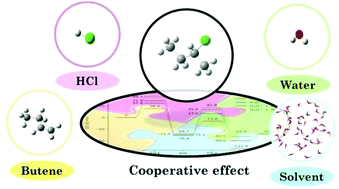Theoretical investigation of the cooperative effect of solvent: a case study†
Abstract
The effect of solvent was investigated at the DFT level, M06-2X/6-31++G(d,p), for the implicit, namely the universal solvent model based on solute electron density (SMD) and hybrid solvation models, and a new pathway for the Markovnikov for the addition of HCl to 1-butene was suggested, incorporating the solvent in the reaction. The results showed that the use of implicit solvent brings greater stabilization for a large part of the reaction coordinates and for the charges of the transition states (TS). Studying the hybrid solvent model, it was shown by quantum mechanics and molecular simulations that although the first solvation shell is composed of approximately 30 solvent molecules, most of the effect comes from just eight solvent molecules explicitly added, with a variation in energy that tends to about −19.3 kJ mol−1. The reaction rates for the hydration of 1-butene were only able to achieve a reasonable accuracy with the addition of three explicit solvent molecules of 5.97 × 10−8 M−1 s−1 and 2.33 × 10−9 M−1 s−1 for the calculated and the experimental values, respectively. This indicates that not only hybrid solvation may be required, but also the number of explicit molecules added may heavily influence the calculated reaction rates. It was found that for the intermediary product of hydration the hydrogen bonds are stronger than average, suggesting a partial covalent characteristic.



 Please wait while we load your content...
Please wait while we load your content...